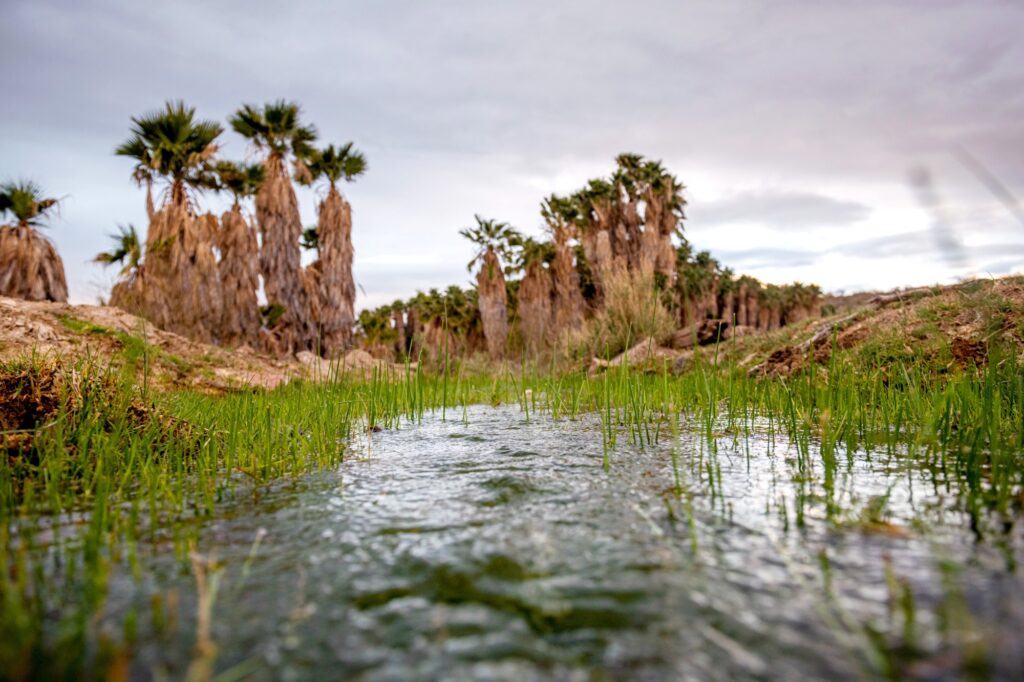
Exploratory wells have damaged the water flow at Ha’ Kamwe’ in Wikieup, Arizona, seen here on Saturday, March 5, 2022. Ha ‘Kamwe is a hot spring sacred to the Hualapai Tribe, which says an Australian company’s proposed lithium mining project threatens. Photo by Ash Ponders | Earthjustice
A federal judge extended a temporary pause of exploratory drilling as part of a lithium mining project near the Hualapai Tribe’s sacred site after the court found that irreparable harm from drilling is likely.
“Lithium exploration is an important public interest at a time when the United States is striving to transition to renewable sources of energy,” Judge Diane Humetewa wrote in the decision. “However, this interest does not outweigh the potential damage the Phase 3 drilling project may cause to Ha’Kamwe’, which is central to the Hualapai Tribe lifeway.
“Nor does it permit a federal agency to short-cut its regulatory consultation obligations or reasoned evaluation of the effects of its undertaking,” she added. “And this Court finds that irreparable harm from the Phase 3 drilling project is not just potential, it is likely.”
GET THE MORNING HEADLINES.
The Big Sandy Valley Lithium Exploration Project allows a subsidiary of an Australian mining company to drill and test more than 100 sites across U.S. Bureau of Land Management land surrounding one of the Hualapai Tribe’s cultural properties, among them Ha’Kamwe’, a medicinal spring sacred to the tribe.
For years, the Hualapai Tribe tried to work with the BLM by actively voicing their concerns about a lithium exploration project near Wikieup, in northern Arizona, but the agency ultimately ruled that any disruptions to the tribe would be temporary, and thus weren’t grounds to block the project.
“We’re pleased with how everything turned out with this decision,” said Ka-voka Jackson, the director of the Hualapai Department of Cultural Resources. “It was definitely worth the wait.”
Jackson said the judge’s decision is reassuring, and it validates the tribe’s long-voiced concerns.
“It feels like we’re being heard, and it also puts it into context that this is a very serious issue and the tribe is taking it very seriously,” she said. “We want to protect these sacred places and protect the water and other resources in the area, not only for us but for the future.”
The court issued a preliminary injunction on Nov. 5, halting all drilling activity as the Hualapai Tribe’s lawsuit continues in court. The decision comes over a month after the tribe presented its argument for the extension in court.
“This doesn’t resolve the case,” Laura Berglan, a senior Attorney for Earthjustice representing the tribe, told the Arizona Mirror.
Berglan said they are pleased that the judge recognized that the drilling threatened the tribe’s resources after hearing from witnesses during the September hearing, and they will continue to work on the case as it moves forward.
“We’re glad the court rejected BLM’s 19th-century mindset, that the company gets whatever they want at the expense of Indigenous communities,” Berglan said in a press release. “BLM should have considered alternatives with less impact on Ha’Kamwe’, like drilling fewer wells or moving them farther from the spring.”
In August, the judge granted the Hualapai Tribe’s initial request for a temporary restraining order against BLM, temporarily freezing the exploratory drilling project.
The restraining order was granted after the Hualapai Tribe filed a lawsuit, following years of the tribe actively voicing its concerns about the mining effort.
“I feel a huge sense of relief today, but we know this is not the end of the story,” Hualapai Tribal Chairman Duane Clarke said in a written statement. “Our people have used Ha’Kamwe’ for centuries for healing, prayer, and rites of passage.
“We are absolutely determined to protect our sacred waters and our way of life from those who would destroy it to enrich themselves,” he added.
Jackson said they also feel fortunate because “this isn’t something that all tribes experience, having courts rule in their favor with issues like this, protecting sacred sites.”
“We feel very lucky, and we’re gonna keep charging forward,” she added.
Ha’Kamwe’ is located within the Hualapai Tribe’s property known as Cholla Canyon Ranch, and the boundaries of the Big Sandy Valley project nearly surround the entire property. Only one portion of the tribe’s land does not border the drilling project.
The spring is recognized as a traditional cultural property and is eligible to be listed on the National Register of Historic Places. The tribe’s lawsuit claims the project’s approval violates the National Environmental Protection Act and the National Historic Preservation Act.
The lawsuit asks for full compliance with the National Historic Preservation Act (NHPA) and the National Environmental Policy Act (NEPA), which includes having the BLM take a “hard look” at the exploration activity’s environmental impacts and consider the implications of its actions on historic properties.
The lawsuit claims that BLM approved the mining project without appropriately considering a reasonable range of alternatives or taking a hard look at water resources under the NEPA and moved forward with the project without providing mitigation measures under the NHPA for Ha’Kamwe’ and other resources essential to the tribe, thus violating both acts.
Out of concern for Ha’Kamwe’, the tribe submitted multiple public comments, sent several letters of concern, and participated in tribal consultations with BLM throughout the Big Sandy Valley Lithium Exploration Project planning phase.
Big Sandy, Inc., a subsidiary of Australian mining company Arizona Lithium, leads the project and has sought approval since 2019. Arizona Lithium is not a direct party in the Hualapai Tribe’s lawsuit, but it filed a motion to intervene. Humetewa granted the request in August, allowing the company to defend against the tribe’s efforts to stop the project.
BLM’s approval of the Big Sandy Valley Project allows the mining company to drill and test up to 131 exploration holes across 21 acres of BLM-managed public land to determine whether a full-scale lithium mining operation could be viable.
YOU MAKE OUR WORK POSSIBLE.

